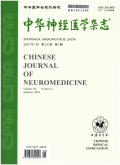短暂性脑缺血发作患者介入治疗术后炎性因子的动态变化及其与再狭窄的关系
Dynamic changes of the levels of inflammation factors after carotid artery stenting and their relation to restenosis in patients with transient ischemic attack
摘要目的 探讨短暂性脑缺血发作(TIA)患者行颈动脉支架置入术(CAS)前后白介素-6(IL-6)、肿瘤坏死因子-α(TNF-α)、C反应蛋白(CRP)的水平变化及其与再狭窄的关系.方法 根据病变情况、手术复杂程度将67例TIA患者分为A组(单支单处病变,置入1个支架,处理1处病变,38例)和B组(单支弥漫性病变或多支多处病变,置入2个支架,处理2处病变,29例),术后1年常规进行头颈血管CTA检查,并根据结果分为再狭窄组(14例)和无狭窄组(48例).检测患者在CAS术前,术后1 h、2周、1个月、6个月、1年血浆IL-6、TNF-α及血清CRP水平,其中CRP检测采用免疫透射比浊法,IL-6、TNF-α检测采用放射免疫测定法.结果随访中1例死亡,4例失访,有14例存在不同程度的狭窄,其中3例再狭窄≥50%.与术前比较,术后1 h、2周、6个月CRP、IL-6水平明显升高,术后1 h、2周、1个月、6个月TNE-α水平明显升高,差异均有统计学意义(P<0.05).与A组比较,B组术后1 h、2周、6个月CRP水平明显升高,术后1 h、2周、1年TNF-α水平明显升高,差异均有统计学意义(P<0.05).与无狭窄组比较,再狭窄组术后1 h、2周、6个月CRP水平明显升高,术后1 h、2周、1个月、6个月IL-6水平明显升高,术后各时间点TNF-α水平明显升高,差异均有统计学意义(P<0.05).结论 IL-6、TNF-α、CRP在CAS后迅速升高,之后逐渐回落,在术后6个月再次出现升高,尤以再狭窄者为著,其可作为预测早期再狭窄的参考指标.
更多相关知识
abstractsObjective To explore the changes of the levels of Interleukin-6 (IL-6), tumor necrosis factor a (TNF-α) and c-reactive protein (CRP) after carotid artery stenting (CAS) and their relation to restenosis in patients with transient ischemic attack. Methods The patients were divided into group A (with 1 stenting and 1 lesion, n=38) and group B (with 2 stenting and 2 lesions, n=29) according to the pathologic changes and complicated degrees of CAS, and all the patients were divided into restenosis group (n=14) and non-restenosis group (n=48) according to the examination results of cervical CTA 1 y after CAS. The levels of EL-6, TNF-α and CRP were measured before CAS and 1 h, 2 w, 1 and 6 mon, and 1 y after stents. The level of CRP was measured by enhanced immunoturbidirnetic assay, and the levels of IL-6 and TNF-a were measured by radioimmunoassay. Results to the follow-up survey, 1 died and 4 were lost. Fourteen had restenosis of different degrees. The restenosis rate more than 50 percent was noted in 3 patients. Compared to those before CAS, the levels of CRP, IL-6 and TNF-α were increased rapidly after CAS (P<0.05). Compared to those in the group A, the levels of CRP, IL-6 and TNF-α in the group B 1 h, 2 w and 6 mon after CAS were obviously increased (P<0.05). Compared to those in the non-restenosis group, the levels of CRP, IL-6 and TNF-α in the restenosis group 1 h, 2 w and 6 mon after CAS were obviously increased (P<0.05). Conclusion The levels of IL-6, TNF-α and CRP increased rapidly after CAS, then reduced gradually and increased once again 6 months after CAS, which was notable in restenosis group. They can be the reference indexes of the forecast for early restenosis.
More相关知识
- 浏览465
- 被引24
- 下载220


相似文献
- 中文期刊
- 外文期刊
- 学位论文
- 会议论文



 换一批
换一批 换一批
换一批



